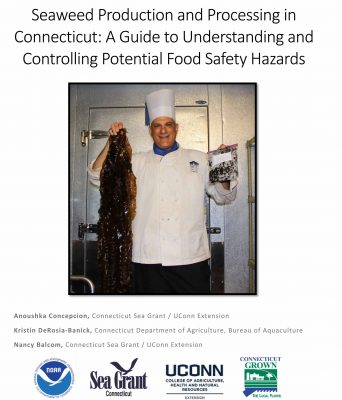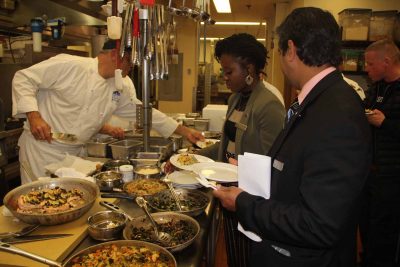 By Judy Benson
By Judy Benson
Connecticut-grown kelp is a little like an unopened packet of summer squash seeds left on a shelf after planting season has passed.
While its potential to become a mainstay of restaurant and home-cooked meals has been promoted in recent years by growers, the media, and others, the reality hasn’t caught up. Kelp harvested from Long Island Sound is nowhere to be found on food store shelves, and only a handful of restaurant menus can claim it as an ingredient in any offerings.
Now though, one of the main logjams preventing kelp from achieving its potential has been removed. After an eight-year effort, a food safety guide for the production and processing of kelp and Gracilaria, another type of edible native seaweed, is now published. Without it, seaweed farmers, buyers and regulators alike were stymied in their efforts to bring edible seaweed into the mainstream. Seaweed could be harvested, but sold only in very limited quantities as a “raw agricultural commodity.”
“Now, with this document, farmers and purchasers know what’s expected, in terms of harvesting and processing methods, temperature controls and a safe growing environment to ensure food safety,” said Anoushka Concepcion, aquaculture extension specialist at Connecticut Sea Grant and one of the authors of the guide.
Concepcion worked with CT Sea Grant Associate Director Nancy Balcom, and Kristin DeRosia-Banick of the state Department of Agriculture Bureau of Aquaculture to create the 34-page document. Titled, “Seaweed Production and Processing in Connecticut: A Guide to Understanding and Controlling Potential Food Safety Hazards,” a pdf of the guide is now available here.
Its publication is a major milestone in helping advance seaweed aquaculture not just in Connecticut but nationwide, DeRosia-Banick said, because neither the federal government nor any other state – even those with established seaweed industries – had anything like it.
“For other seafood commodities,” said DeRosia-Banick, environmental analyst at the Bureau of Aquaculture, “there is a wealth of federal regulation in addition to extensive fish and fisheries guidance to rely upon. It became quickly obvious that similar regulation and guidance for seaweed was completely lacking at the federal or state level in the United States.”
Over the past decade, interest in growing seaweed in the Sound for human consumption has been increasing, as growers sought to compete with edible seaweed imported from overseas. Before that, much of the commercial seaweed raised in the United States had been used for products other than food, including fertilizer and cosmetics.
As growers sought permits from the state to set up their farms in the Sound, DeRosia-Banick said, she and other state regulators realized a mechanism had to be created to ensure the product would be safe to eat. That led the partnership between the Bureau of Aquaculture, Sea Grant, the state Department of Public Health and the Connecticut Agricultural Experiment Station to do the years of testing and data analysis on seaweed samples to understand the health hazards, and set the standards growers would have to meet to avoid them. These include minimizing risks of pathogens such as Salmonella and contamination from waters polluted with heavy metals and PCBs.
“This is a way to be proactive rather than reactive,” said Concepcion. Without establishing guidelines, “the state could be liable if someone becomes ill from eating seaweed grown in Long Island Sound.”

The guidelines are based on existing seafood safety protocols known as HACCP (Hazard Analysis and Critical Control Point), Concepcion noted, but tailored to the unique characteristics of seaweed. Growers will need to take a HACCP course along with obtaining permits that conform to the guidelines for water quality and other parameters.
DeRosia-Banick said the groundbreaking work done in Connecticut in creating the guide has been shared at national scientific and professional conferences.
“This issue has been brought to the attention of federal regulators, academic researchers, state permitting agencies and Sea Grant programs across the nation,” she said. “We are now working with partners around the country, sharing our experience here in Connecticut and leading these conversations at the national level.”
Next month, Concepcion will have a select audience for spreading the word about the new guide, when the National Sea Grant Seaweed Hub meets for the first time for a three-day conference in Providence, R.I. Concepcion led the establishment of the hub, which has been awarded $1.1 million in federal funds, along with colleagues in nine other Sea Grant programs. It will serve as a central clearinghouse for science-based, practical resources about seaweed aquaculture and extension efforts.
“This is the first-ever guide to ensure that seaweed is safe for consumption,” she said. “We were happy to work with the state to develop guidance that both they and industry can utilize.”
Judy Benson is the communications coordinator at Connecticut Sea Grant.